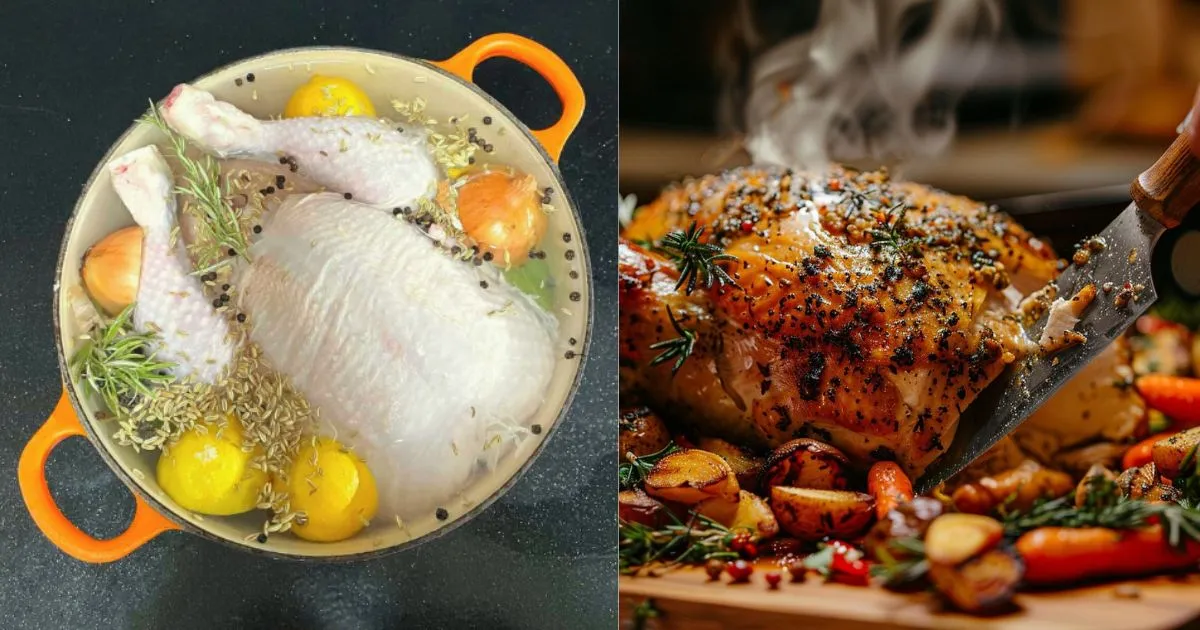Brined vs. Non-Brined Chicken: Best Recipes Ever
Table of Contents
Brined vs. Non-Brined Chicken: Best Recipes Ever
The debate over brined versus non-brined chicken has sparked interest among many. Brining involves soaking chicken in a saltwater solution. It’s seen as a game-changer in cooking poultry. This article will explore the benefits of brining and guide you on how to cook the perfect chicken, whether you choose to brine or not.
Key Takeaways
- Brining chicken can result in more tender and juicy meat with a flavorful infusion.
- The brining process involves soaking the chicken in a saltwater solution, which can enhance the overall taste and texture.
- Non-brined chicken has its own advantages, such as a more concentrated natural flavor.
- Proper preparation and cooking techniques are crucial for both brined and non-brined chicken to achieve the desired outcome.
- Understanding the differences between brined and non-brined chicken can help you make an informed decision based on your personal preferences and culinary goals.
What is Brining Chicken
Brining is a simple yet effective technique that can elevate the flavor and texture of your chicken dishes. It involves submerging the chicken in a saltwater solution. This allows the meat to absorb the brine and become more tender and juicy.
The brine solution typically consists of water, salt, and sometimes additional seasonings or aromatics. By soaking the chicken in this flavorful mixture, the meat becomes infused with the brine’s flavors. This results in a more succulent and delectable final product.
But how exactly does brining work, and what are the benefits of this culinary method? Let’s dive into the details of what brining chicken entails and why it’s a game-changer in the kitchen.
The Science Behind Brining
The process of brining chicken is based on the principles of osmosis and diffusion. When the chicken is submerged in the brine solution, the salt content in the brine is higher than in the chicken’s cells. This difference in salt concentration causes the water in the brine to be drawn into the chicken. This process hydrates the meat, making it more tender.
Additionally, the salt in the brine helps to denature the proteins in the chicken. This breaks down the tough muscle fibers. As a result, the meat becomes more succulent and juicy. The result is a chicken that is not only flavorful but also remarkably moist and tender.
Preparing the Brine
- Start with a ratio of 1/4 cup of salt per 1 cup of water.
- You can also add aromatics like garlic, herbs, spices, or citrus to the brine for extra flavor.
- Bring the brine to a boil to dissolve the salt, then allow it to cool completely before submerging the chicken.
- The chicken should be fully submerged in the brine, so you may need to weigh it down with a plate or other heavy object.
By understanding the science behind brining and following the proper steps, you can unlock the secrets to what is brining chicken and how to brine chicken. This will help you achieve truly remarkable results in your kitchen.
The Benefits of Brining Chicken
Brining chicken is a game-changer for juicy, flavorful cooking. This simple technique offers many benefits. Let’s explore the two main advantages of brining chicken.
Tender and Juicy Meat
The brine solution breaks down the chicken’s protein, making it tender and moist. As the chicken soaks, the salt and seasonings penetrate deep. This ensures every bite is full of flavor.
This makes brined chicken much better than plain, unseasoned poultry.
Flavorful Infusion
Brining also helps the chicken absorb seasonings and aromatics. By soaking in a flavorful brine, the chicken takes on herbs, spices, and citrus. This boosts the taste, making meals more enjoyable.
Brining chicken, whether roasting, grilling, or other methods, is a must. The benefits of brining chicken and reasons to brine chicken are clear. You’ll get juicier, more flavorful results every time.
Preparing the Perfect Chicken Brine
Brining chicken is a simple yet effective way to ensure tender, juicy, and flavorful results every time. To create the perfect chicken brine, focus on the essential ingredients and proper time and temperature guidelines.
Essential Ingredients
The basic chicken brine recipe includes a few key components:
- Water: This forms the foundation of the brine solution.
- Salt: The right amount of salt helps to season the chicken and lock in moisture.
- Sugar (optional): Adding a touch of sugar can help balance the saltiness and promote caramelization.
- Aromatics (optional): Herbs, spices, citrus, or other aromatic ingredients can infuse the chicken with additional flavor.
Brining Time and Temperature
Once you have your brine ingredients prepared, it’s time to submerge the chicken and let the magic happen. The recommended brining time can vary depending on the size of the chicken, but as a general guideline:
- For whole chickens or large cuts, brine for 4-24 hours in the refrigerator.
- For smaller chicken pieces, brine for 30 minutes to 4 hours.
It’s crucial to keep the chicken submerged in the brine and refrigerated throughout the process to prevent bacterial growth. The ideal brining temperature should be between 35-40°F (2-4°C) for maximum flavor and texture development.
| Chicken Cut | Brining Time | Brining Temperature |
|---|---|---|
| Whole Chicken | 4-24 hours | 35-40°F (2-4°C) |
| Large Chicken Pieces | 4-24 hours | 35-40°F (2-4°C) |
| Small Chicken Pieces | 30 minutes to 4 hours | 35-40°F (2-4°C) |
By following these simple guidelines, you’ll be well on your way to mastering the art of how to brine chicken. You’ll create the most delicious, juicy, and flavorful chicken dishes.
Non-Brined Chicken: Pros and Cons
Brining chicken has many benefits, but cooking non-brined chicken has its own perks. For those who love a strong chicken taste, chicken without brine is a great choice. It also makes cooking quicker and easier.
But, there are downsides to not brining. Non-brined chicken can dry out easily when cooked. This means you need to watch it closely and baste it often. This can be hard, especially for beginners or when cooking big pieces of chicken.
Pros of Non-Brined Chicken
- More concentrated chicken flavor
- Quicker and simpler cooking process
Cons of Non-Brined Chicken
- Increased risk of drying out during cooking
- Requires more attentive monitoring and basting
Choosing between brined and non-brined chicken depends on what you like and what you’re making. Knowing the good and bad points of each helps cooks decide what’s best for them.
Cooking Techniques for Brined and Non-Brined Chicken
Choosing the right cooking method can greatly affect the taste of chicken, especially when comparing brined and non-brined. Let’s look at the best ways to cook these chickens for delicious results.
Roasting Brined and Non-Brined Chicken
Roasting is a great method for both brined and non-brined chicken. But, the approach can differ a bit. Brined chicken is often more moist and flavorful. It might need a lower oven temperature and longer cooking time to stay tender.
Non-brined chicken might do better with a higher oven temperature and shorter cooking time. This helps keep its juices in and prevents dryness.
Grilling Brined and Non-Brined Chicken
Grilling is also a fantastic way to cook both types of chicken. The high heat and smoky flavor from the grill enhance the taste. Brined chicken can get a nice caramelized crust while staying juicy inside. Non-brined chicken can also be grilled well, but it needs more care to avoid drying out.
Whether you roast or grill your chicken, watching the cooking time and temperature is crucial. This ensures the best taste for both brined and non-brined chickens.
Conclusion
Choosing between brining or not brining your chicken depends on what you like and what you want to achieve. Brining can make your chicken juicier and tastier. But, some people might prefer not to brine for their own reasons.
It’s important to try both ways to see which one you like best. Knowing the good points of brining and non-brining helps you decide. This way, you can pick the method that fits your cooking style and recipes.
Deciding to brine or not is up to you. But, trying both can make your chicken dishes even better. You’ll learn how to make your chicken dishes more flavorful, matching your taste and cooking style.
FAQ
What is brining chicken?
Brining chicken means soaking it in a salty solution before cooking. This method makes the chicken more tender and juicy. It also boosts the flavor.
What are the benefits of brining chicken?
Brining chicken has many benefits. It makes the meat tender and juicy. The brine also adds flavor, making the chicken taste better.
How do I prepare the perfect chicken brine?
To make a great chicken brine, you need a few key ingredients. You’ll need water, salt, and sometimes sugar or herbs. The chicken goes into the brine in the fridge for a few hours or overnight.
What are the pros and cons of non-brined chicken?
Non-brined chicken has its own perks. It can taste more intense and is quicker to cook. But, it might dry out if not watched closely.
How do I cook brined and non-brined chicken?
You can cook both brined and non-brined chicken in many ways. Brined chicken might need different cooking times and temperatures. Grilling gives a nice crust, while roasting ensures the meat is full of flavor.

